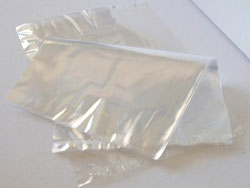Without a doubt, cellophane bags and their derivatives have been around for a long time now; they are used as packaging material in the food industry and have many industrial applications, as well. Made out of regenerated cellulose, cellophane bags happen to be biodegradable, but that does not disappear the detrimental effect it has on our environment. Even though cellophane is 100 percent biodegradable, the manufacturing process is far from being eco-friendly and the result is that the numerous disadvantages of cellophane bags.
Popularity of Cellophane Bags
Cellophane bags are widely used for the following activities:
- Gift wrapping
- Treat bags
- Plastic cutlery
- Food wraps at parties and gatherings
- Shopping bags
- Linings of paper cups
- Nappies
- Packaging of edibles in general
Certainly, the unique attributes that cellophane bags possess include heat sealing and permeability to oil and even bacteria, which has proven to be quite effective when it comes time to protect food. However, some of the disadvantages of cellophane bags include the limited shelf life that they give perishables as opposed to canned food, for example.
Shortcomings of Cellophane Bags
As you can imagine, the disadvantages of cellophane bags cannot be overlooked because there are health-related issues regarding the products. Although many consumers prefer cellophane bags over paper bags, there are many items that should not be wrapped with cellophane bags. For example, a cigarette can easily make a hole on a cellophane bag; thus, cellophane bags may not be suited for rugged use. Furthermore, cellophane bags might be biodegradable but it also takes time for the particles to disintegrate and landfills are piling up with them. Therefore, the use of cellophane bags is currently being discouraged since its production processes contribute largely to the rise of carbon dioxide in our atmosphere, which is the primary cause of climate change and ecological imbalance.
The production process of cellophane bagsis similar to that of rayon, and it involves various chemical processes to convert cellulose to cellophane. Most of the raw materials used in the manufacture of commercial cellophane have a petroleum base – they are generally made from fossil fuel derivatives which are non-renewable sources of energy. Also, the production process spends a lot of these fossil fuels for their energy, which in turn expels more carbon dioxide into the atmosphere. Hence, environmental pollution and degradation is one of the major disadvantages of cellophane bags.
Looking to Move Forward
Perhaps the best way to fight the disadvantages of cellophane bags is by reusing them and recycling them. It’s imperative that you don’t dispose of your cellophane bags right away, this way you can have them handy whenever it’s time to put them to use again. In today’s world, going green and being eco-friendly is the new mantra, and finding suitable alternatives or inventing a better manufacturing process backed up by green technology can prove to be extremely beneficial. In short, you should use the disadvantages of cellophane bags to produce a better future by accomplishing the following:
- Zero environmental harm
- Safe product for children
- Minimum pollution in all stages of production
- Using renewable sources of energy for the fabricating processes
- Keep the features that make cellophane bags extremely useful

- Home
- Benefits Of Cellophane Bags
- Biodegradable Cellophane Bags
- Bulk Cellophane Bags
- Buy Cellophane Bags
- Candy Cellophane Bags
- Cellophane Art Bags
- Cellophane Bags Faqs
- Cellophane Bags
- Cheap Cellophane Bags
- Compostable Cellophane Bags
- Considerations Cellophane Bags
- Cupcake Cellophane Bags
- Custom Cellophane Bags
- Custom Printed Cellophane Bags
- Customized Cellophane Bags
- Decorative Cellophane Bags
- Different Colors Of Cellophane Bags
- Different Shapes Of Cellophane Bags
- Different Sizes Of Cellophane Bags
- Disadvantages Of Cellophane Bags
- Discount Cellophane Bags
- Discovered It Cellophane Bags
- Expert Insight Into Cellophane Bags
- Facts About Cellophane Bags
- Features Of Cellophane Bags
- Function Of Cellophane Bags
- Gift Basket Cellophane Bags
- History Of The Cellophane Bags
- How Are Cellophane Bags Used
- Misconceptions About Cellophane Bags
- Party Cellophane Bags
- Paw Print Cellophane Bags
- Personalized Cellophane Bags
- Personalized Cellophane Candy Bags
- Plastic Cellophane Bags
- Polka Dot Cellophane Bags
- Potential Of Cellophane Bags
- Printed Cellophane Bags Wholesale
- Printed Cellophane Bags
- Resealable Cellophane Bags
- Sealable Cellophane Bags
- Self Adhesive Cellophane Bags
- Warning For Cellophane Bags
- What Are Cellophane Bags Used For
- When Are Cellophane Bags Used
- Where Are Cellophane Bags Used
- Where To Buy Cellophane Bags
- Who Invented The Cellophane Bag
- Wholesale Cellophane Bags
- Wholesale Cellophane Gift Bags
- Why Are Cellophane Bags Used
- Cellophane Bags
- Cellophane Bags For Occassions
- Clear Cellophane Bags
- Colored Cellophane Bags
- Cone Shaped Cellophane Bags
- Extra Large Cellophane Bags
- Food Cellophane Bags
- Large Cellophane Bags
- Small Cellophane Bags
- Types Of Cellophane Bags
- What Can Cellophane Bags Be Used For
